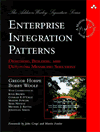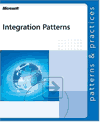Some of the books in this annotated bibliography on enterprise integration are dated now, but most of them are still relevant because they're not limited to a specific technology. I own almost all of the books listed here and have read all of the good ones :-) Also see books I authored or co-authored.
| | |
 | Enterprise Integration Patterns
Hohpe, Woolf
Addison-Wesley, 2003 |  |
| This book includes all 65 patterns from this site plus more examples and lots of edits. The book was born out of the absence of books that focus on the design of messaging systems without being limited to a specific technology. |
|
 | Integration Patterns
Trowbridge, Roxburgh, Hohpe, Manolescu, Nadhan
Microsoft, 2004 |  |
| The Microsoft Patterns and Practices group published a book that I contributed to for a few months. The content has been on-line on MSDN for a while but it is nice to have it in printed form. The book complements our book quite well as it focuses on higher-level integration constructs and uses larger industry examples. It should be a worthwhile read even for people outside of the Microsoft community because the architecture and design patterns are universally applicable. Naturally, the implementation examples use ASP.NET and BizTalk Server 2004. |
|
 | Data and Reality
William Kent
1stBooks, 1978, 2000 |  |
| Hold on, a 20-year-old book on EAI? Yes. Not about EAI technologies, but about one of the toughest issues in integration: how to model and integrate data. Kent explains why highways are not painted red and rivers do not have county lines run down the middle, even though it likes like that on a map! The classic book tells us why modeling reality inside a computer system is so hard. You can get the hardcover at Amazon for $45, but 1stBooks offers an electronic version for $8.95 or a $30 paperback version at http://www.1stbooks.com. |
|
 | IT Architectures and Middleware: Strategies for Building Large, Integrated Systems (2nd ed)
Chris Britton
Addison-Wesley, 2004 |  |
| Reading Britton's book makes me believe that he has actually spent some time solving real integration problems. After the mandatory 'History of Integration', he quickly dives into the tougher problems of integration: how to deal with exceptions in a message queuing environment, issues with distributed two-phase commits, what to do about performance. I am also glad to see a whole chapter about security and systems management as well as a section on managing change. While this book resists diving into too much technical detail (no code here), it is definitely recommended reading for aspiring integration architects. |
|
 | The Power of Events: An Introduction to Complex Event Processing in Distributed Enterprise Systems
David Luckham
Addison-Wesley, 2002 |  |
| A great book on what it means to be event-driven. Good treatment of event aggregation, event hierarchies and causality. David is a language guy so expect a technology neutral, but formal treatment without being too academic. Required reading for everyone who throws the "EDA" (Event-Driven Architecture) term around! |
|
 | Communicating and Mobile Systems
Robin Milner
Cambridge Univ Press, 1999 |  |
There is a lot of ranting these days in the BPEL community about pi-calculus so I figured I stick the original reference on here. If you are not into reading academic texts but want to spot pi-calculus con artists, read JJ's excellent overview:
www.ebpml.org/pi-calculus.htm |
|
 | Enterprise Integration: An Architecture for Enterprise Application and Systems Integration
Fred Cummins
John Wiley & Sons, 2002 |  |
| I am delighted to see an OMG book that does not simply belabor the greatness of CORBA and MDA. In fact, most mentions of 'CORBA' seem to be relegated to the mandatory 'About the OMG' intro. The word 'model' may still appear a tad bit often, but the book does give a comprehensive treatment of the enterprise architecture considerations inherent in integration work. It also goes into a little more technical detail than Linthicum -- we even get to see some UML diagrams! The book makes a good checklist of items to consider, but stops short of explaining how to actually construct working solutions. |
|
 | Enterprise Application Integration: A Wiley Tech Brief
William A. Ruh
John Wiley & Sons, 2000 |  |
| A bit dated, but still a relevant overview of basic integration technologies: RPC, Data Access, MOM, Distributed Objects, TP Monitors. It's a pretty think book (224 pages), so I would recommend picking one up from the Amazon marketplace for under 20 bucks. |
|
 | Enterprise Application Integration
David Linthicum
Addison-Wesley, 2003 |  |
| David Linthicum's third book on EAI. Thoroughly reworked, it now includes Web Services, Service Oriented-Architectures and related topics. A worthwhile read for IS managers needing to come up to speed on EAI terminology and technologies at a high level. |
|
 | Integration Models: Templates for Business Transformation
Laura Brown
Sams, 2000 |  |
| This book does not describe specific integration technologies, but presents a collection of eight modeling templates that help describe an integration solution.
It is apparent that the author has spent some time on actual integration projects -- something not to be taken for granted!
The templates are not as structured as patterns, but they are visually intuitive, which is important to get the big picture.
Still, I would have enjoyed a bit more thorough treatment on the information presentation aspect of the templates.
For example, I am still wondering why the Wave template is a wave and not a layer. |
|
 | Middleware Enterprise Application Integration
Daniel Serain
Springer Verlag, 2002 |  |
| Serain describes and compares specific integration and distributed component methodologies, such as CORBA, OLE/COM, Java RMI. I felt like some of the sections were page fillers, e.g. 'Introduction to the Internet' and 'Introduction to Object Technology'. Maybe Springer thought that for 65 bucks you should get more than 200 pages. |
|
 | TCP/IP Illustrated, Volume 1: The Protocols
W. Richard Stevens
Addison-Wesley, 1994 |  |
| Not a book on EAI, but a book on low-level networking. A lot of the message-oriented EAI solutions are based on TCP/IP connectivity. They also have to deal with similar problems like out-of-sequence packets (or messages). This is the ultimate reference to figure out what is really going on under the covers. Especially relevant if you are working with multi-cast / UDP style transport layers. |
|
 | TCP/IP Illustrated, Volume 2: The Implementation
Gary R. Wright, W. Richard Stevens
Addison-Wesley, 1995 |  |
| The continuation of Vol 1. |
|


























